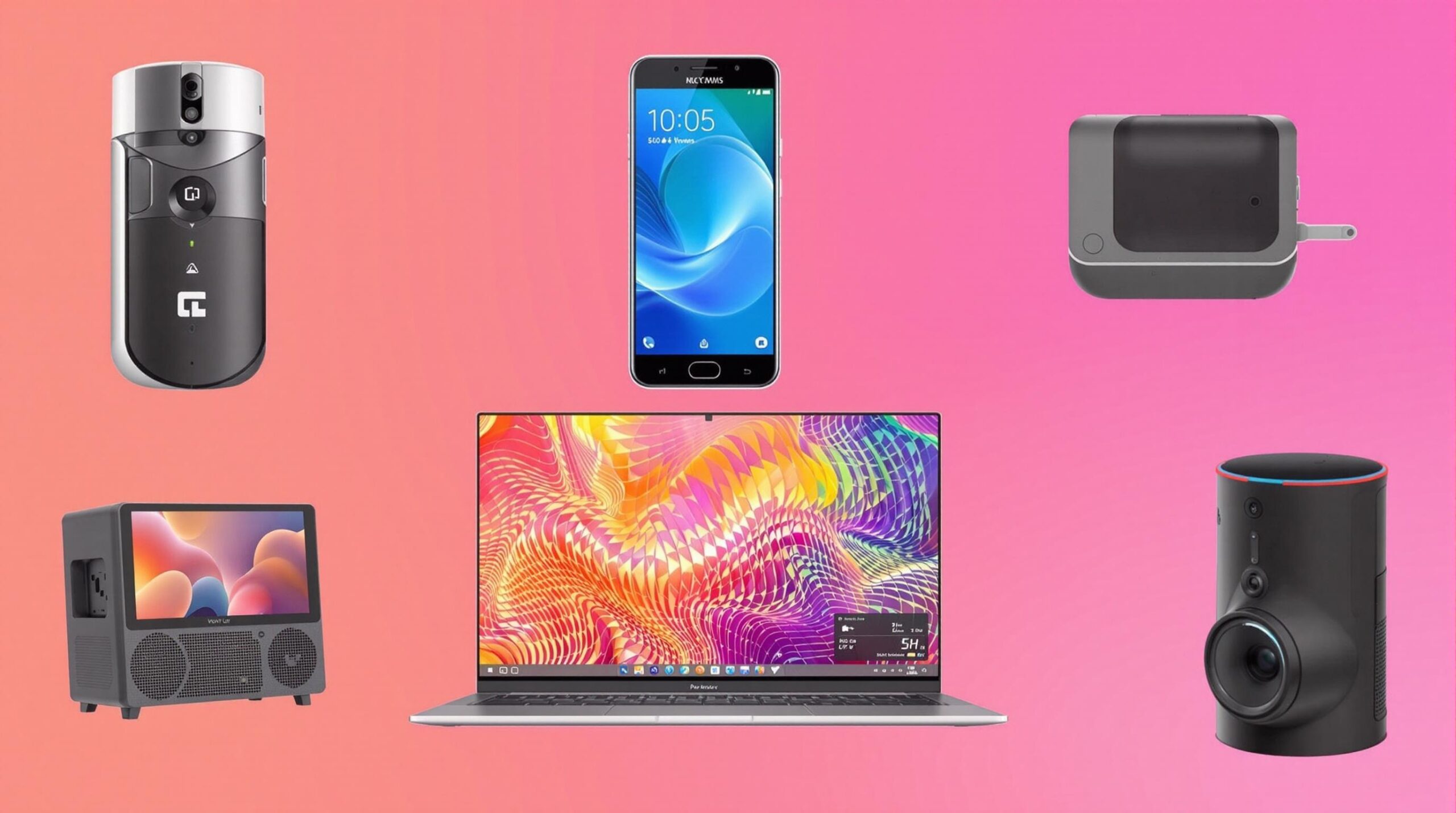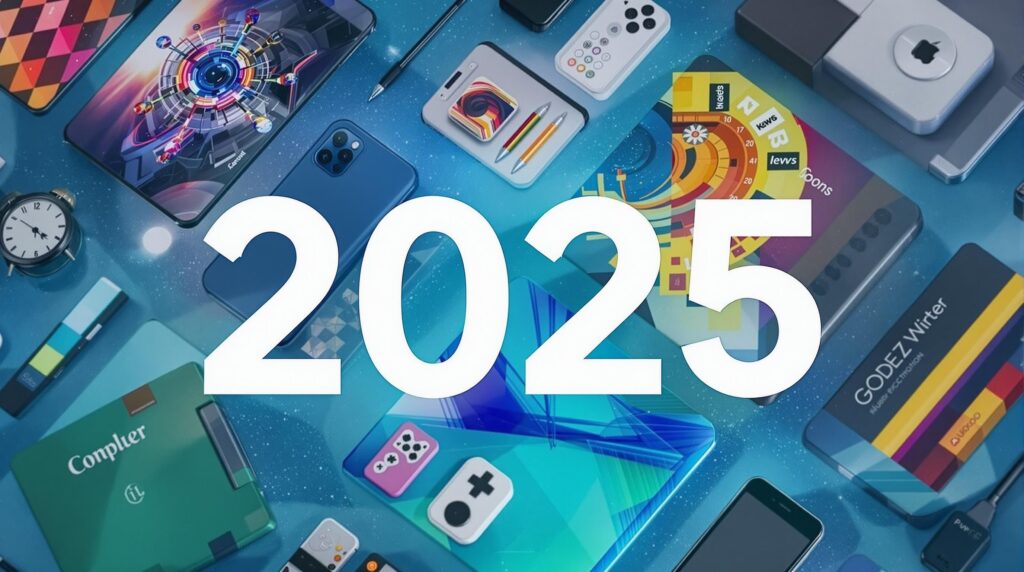The digital landscape of 2025 has dramatically transformed how we interact with technology, with innovative news gadget releases showcasing unprecedented levels of AI integration, modularity, and personalization. From cutting-edge televisions with brightness levels once thought impossible to handheld gaming devices that rival desktop performance, this year’s top electronics represent a significant leap forward in both capability and user experience.
Key Takeaways
- Premium televisions now feature 10,000 nits peak brightness and AI-driven audio systems that track viewer positioning
- New modular smart home robots offer swappable functionality modules for customized domestic assistance
- The AR wearables market is experiencing 40% compound annual growth through 2030 according to Deloitte
- Revolutionary battery-swapping technology reduces charging times by 95% compared to wired solutions
- Digital minimalism is driving a new category of distraction-free mobile devices with multi-day battery life
https://www.youtube.com/watch?v=PFFR8Wl4Dls
Immersive Home Entertainment: Next-Generation Television Technology
The home entertainment landscape has been completely reimagined in 2025, with television technology reaching new heights of immersion and visual fidelity. LG’s G5 OLED TV stands as the premier offering with its groundbreaking 10,000 nits peak brightness – a five-fold increase from high-end models just two years ago. This exceptional brightness is complemented by AI-driven head-tracking audio that automatically adjusts sound positioning based on viewer location.
Panasonic has answered with its Z95B OLED, featuring an innovative four-layer OLED structure that delivers 2,500 nits brightness and incorporates a built-in 7.1.2-channel soundbar with dedicated up-firing speakers. Meanwhile, Samsung’s Frame Pro TV continues to blur the line between art and technology with its QD-Mini LED panels and sophisticated AI upscaling technology that converts standard content to stunning 8K resolution.
The global demand for these advanced smart TVs shows no signs of slowing, with industry data pointing to a 12% year-over-year growth in TV shipments driven specifically by AI-enhanced displays.

Modular Smart Home Solutions: Customizable Robots and Portable Displays
The K20 Plus Pro robot represents a significant advancement in home automation, featuring a revolutionary modular design that allows users to swap functionality modules for different tasks. Priced at $899 for the base model, this versatile robot can be equipped with air purification, security monitoring, and video streaming capabilities. Future upgrades will include AI-driven robot arms capable of performing domestic tasks like dishwashing, available as $199 add-on modules.
LG’s StanbyMe 2 offers a fresh take on portable displays with its 27-inch 1440p detachable screen, 4-hour battery life, and wall-mount compatibility. Priced at $999, this versatile display features a panel 2.5 times brighter than its predecessor and comes with a protective folio case. The device has earned praise from 87% of beta testers specifically for its portability, making it ideal for remote workers who need flexibility in their setup.
Next-Generation Computing: Powerful GPUs and Handheld Gaming Systems
NVIDIA’s RTX 5090 GPU has redefined high-performance computing with its ability to deliver consistent 120 FPS in 4K gaming scenarios. Utilizing DLSS 4 frame-generation technology and 32GB of GDDR7 memory, this $1,999 graphics powerhouse offers twice the performance of its predecessor. For comparison, AMD’s competing Radeon RX 8900 XT offers 24GB of GDDR6X memory, highlighting NVIDIA’s current technical advantage.
The handheld gaming market continues its rapid expansion with the Lenovo Legion Go S, a $499 portable gaming PC running Steam OS with a 120Hz variable refresh rate screen and AI frame smoothing technology. This innovative device can run AAA titles for up to 4 hours on a single charge and supports 65W fast charging for quick power-ups. According to data presented at CES 2025, the handheld PC segment is growing at an impressive 30% year-over-year rate, demonstrating strong consumer interest in portable gaming solutions.
AR Smart Glasses: The New Interface for Daily Life
Augmented reality wearables have made significant strides in both capability and comfort, with the Rokid Max Pro offering 50-degree field-of-view micro-OLED displays at $699. These premium glasses include live translation features and teleprompter modes for professional use, though they still trail behind Microsoft’s HoloLens 3 with its 70-degree field of view.
The luxury segment has seen interesting developments with the Ferrari x Ray-Ban collaboration, which integrates Meta AI Vision for advanced object recognition at $549. This partnership demonstrates how AR technology is entering the fashion-forward accessory space while maintaining practical functionality.
According to Deloitte’s market analysis, the AR wearables segment is positioned for 40% compound annual growth through 2030, making it one of the fastest-expanding categories in consumer electronics.
Minimalist Mobile Technology: Less Screen, More Life
In direct contrast to the feature-packed smartphones dominating the market, a new category of minimalist devices has emerged to address growing concerns about digital overload. The aptly named Minimal Phone features energy-efficient E Ink displays and a physical QWERTY keyboard, delivering an impressive 4-day battery life from its 4,000mAh power cell – significantly outlasting the iPhone 15’s 3,349mAh battery.
Nothing’s Phone (2a) Micro concept pushes the compact form factor even further with its 4-inch screen and signature Glyph LED interface, catering to users seeking a smaller digital footprint. According to research from Trend Hunter, this shift toward digital minimalism is being driven primarily by Gen Z, with 35% preferring streamlined tech that reduces distraction and screen time.
Instant Power Solutions: Revolutionary Charging Technology
The Swippitt PowerGrip has completely reimagined mobile device charging with its innovative battery-swapping system that replaces depleted 3,500mAh batteries in just 2 seconds. Priced at $299, this system supports up to five simultaneous charges, effectively reducing charging time by 95% compared to traditional wired solutions, which typically require 30+ minutes with 30W chargers.
Beyond pure convenience, the PowerGrip offers significant sustainability benefits. Each of its batteries is rated for 1,000 charge cycles, substantially reducing electronic waste compared to disposable power banks. This combination of speed and environmental consciousness represents a fundamental shift in how we approach device power management.
Premium Audio and Health Wearables: Sound and Wellness Integration
Audioengine’s HD4 speakers deliver exceptional audio quality with 100W RMS output and a 24-bit/192kHz DAC for lossless audio reproduction. At $499, these compact powerhouses outperform many larger systems, including the Sonos Era 300 with its 75W output. For those seeking bigger sound, Klipsch’s Music City Party Speakers offer 360-degree audio projection and powerful 8-inch subwoofers for $699.
Health-focused audio wearables have seen significant innovation with the Shokz OpenDots One, which uses bone-conduction technology to deliver audio while simultaneously monitoring heart rate, blood oxygen levels, and sleep patterns. Priced at $199, these IP67 water-resistant earbuds offer 8 hours of playback and achieve 93% accuracy in sleep staging – outperforming Fitbit’s 89% accuracy rating.
The convergence of premium audio and health monitoring reflects broader market trends, with premium audio sales rising 22% in Q1 2025 and wearable health device revenue projected to reach $100 billion by 2026.
Sources
Gear Patrol – Best New Gadgets and Hi-Fi Releases of 2025
Your Story – Top CES Gadgets of 2025: Redefining the Future of Technology
Tom’s Guide – Best of CES 2025: The top 25 new gadgets
Technology Innovators – Digital Lifestyle Magazine Features
Trend Hunter – Top 100 Tech Trends for 2025
Deloitte Insights – 2025 Technology Industry Outlook
ZDNET – CES 2025: The 25 best products that we’re still thinking about



